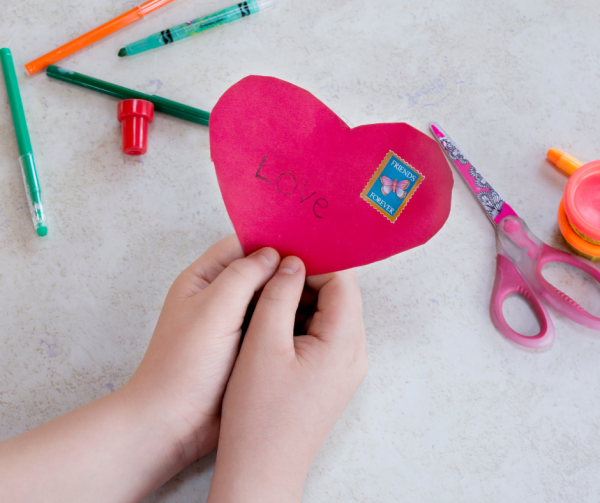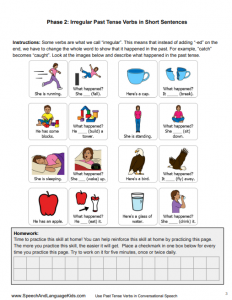Valentine’s Day Speech Therapy Activities

It’s almost Valentine’s Day! Valentine’s Day means telling the people you love how much you care about them and eating lots of chocolate! Here are some fun Valentine’s Day activities you can do with your child or your clients to celebrate Valentine’s Day and work on his speech and language skills at the same time.
Valentine’s Day Activities #1:
Make Valentines: Naming Familiar People, Making Requests, Possessive ‘s
Before the activity, cut some red, pink, and purple hearts out of construction paper. Then, gather a bunch of materials that your child may want to create valentines. You could use glue, scissors, extra paper, lace, glitter, markers, crayons, colored pencils, beads, stickers, or anything else that might be fun to add to a valentine. Tell your child that you’re going to make valentines for the people that she cares about. Ask her to name the people in her life that she would like to make valentines for.
If she is able to write, have her write each person’s name on the back of a heart, or write them for her if she needs help. Also, if she is older, have her write one thing she likes about that person. Make sure she writes with proper grammar and spelling. If your child isn’t able to do this, you can skip this part or you can write a message yourself, like “Happy Valentine’s Day”. Once you have all of the hearts filled out, flip them over but keep the hearts as well as the materials next to you. Ask your child, “Whose Valentine would you like to make first?”
When your child answers, make sure she says the ‘s on the end of the name that marks the possessive. For example, your child could say “Grandma’s” or “I want to make Grandma’s valentine”. If she leaves off the ‘s, say it for her correctly and have her repeat it back. Give her that person’s heart and then keep all of the materials in front of you.
Don’t let her have any until she uses her words to ask for them. Try to expect just a little bit more from her than she’s comfortable with. For example, if she is used to pointing at things to let you know what she wants, have her say the word or use sign language to request. If she’s able to use just one word at a time, have her pair two words together to request, like “want glue”. If she is speaking with more words, make sure that she uses all of the appropriate grammatical markers like “a”, “the”, “can”, “is”, etc.
You can show her how to use the materials once she asks for them or you can also help her practice asking for help if she doesn’t know how to do something. Let her decorate the valentines however she wants. That will make them more special!
Valentine’s Day Activities #2:
Making Chocolate-Covered Strawberries: Following Directions, Vocabulary
This is one of my favorite Valentine’s Day activities to do with kids because they get so excited about it! Before the activity, create a “recipe” that your child will follow to make the strawberries. Make it as simple or as complex as your child can handle. For young children, you may just have a few steps with pictures like “dip strawberry, put on tray, put in refrigerator”. For older children, you may have a more complex recipe with no pictures that includes many steps such as “put chocolate in bowl, put bowl in microwave, set the time to 1:00…”
Basically, here’s how I recommend doing this. Go to the store and purchase strawberries and some melting chocolate. They usually have this in the baking aisle at the grocery store or I’ve also found it at craft stores like Michael’s. Melt the chocolate however you want. You can use a microwave (stir often to avoid burning) or the stove. Then, dip the strawberries in the chocolate and lay them down on a cookie sheet that is lined with parchment paper or wax paper. You can stick them in the refrigerator or freezer to cool faster. Once the chocolate is hard again, eat and enjoy!
Like I said before, you can break this down into as few steps as you need for your child. As you’re working on making these, try using as much descriptive vocabulary as you can. You can talk about hot and cold or melted and solid, you can talk about how the strawberries and chocolate tastes, or you can describe the colors you see while making these. You can also talk about the nouns and verbs associated with this activity. For example, you can practice the words chocolate, strawberry, bowl, spoon, microwave, freezer, cookie sheet, stir, dip, set down, put in, eat, etc.
Valentine’s Day Activities #3:
Turn Your Speech Words into Valentines
When children have a list of speech words that they need to practice, it’s not always very much fun to just sit there and say them over and over again. You can have fun with your child’s word list by turning them into valentines and mailing them in a pretend mailbox. If your child doesn’t already have a list of words he’s working on, create one using the sound that he is working on (for example, all /s/ words). Find something you can use as a mailbox, such as a shoebox or basket.
You could even have your child make his own mailbox by decorating a small box and cutting a slit for the mail. Write or draw your child’s words on small pieces of paper (if you don’t already have a stack of cards for him to use) and put them in a pile. Each time your child says a word, have him pretend it’s a valentine and put it in the mailbox and tell you who he’s mailing it to. He could even put it in an envelope first if he wants (this would be good fine motor work!). After they are all in the mailbox, pretend that they are the valentines your child got in the mail. Have him open them up and read each one. He could even make up someone that is from (like the president!).
If your child is pretty good at saying the words by themselves and needs something a little harder, have him create a sentence that his valentine might be writing to him that uses the word. For example, if your child’s word is “cat”, he might come up with a valentine like “Dear Andy, I bought you a cat! Happy Valentine’s Day! Love, The President!”.

About the Author: Carrie Clark, MA CCC-SLP
Hi, I’m Carrie! I’m a speech-language pathologist from Columbia, Missouri, USA. I’ve worked with children and teenagers of all ages in schools, preschools, and even my own private practice. I love digging through the research on speech and language topics and breaking it down into step-by-step plans for my followers.
Fun Fact: I sunburn very easily, it’s kind of ridiculous. I have to be very careful when out in the sun, especially if we travel South at all.
Connect with Me:







Leave A Comment